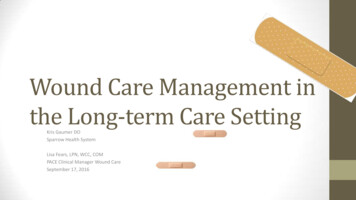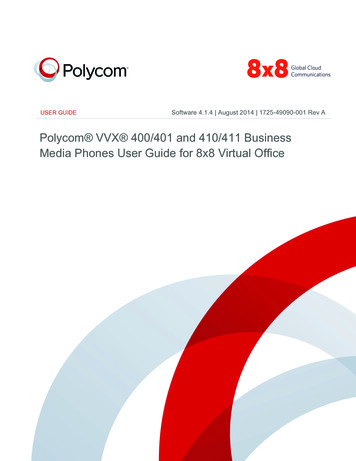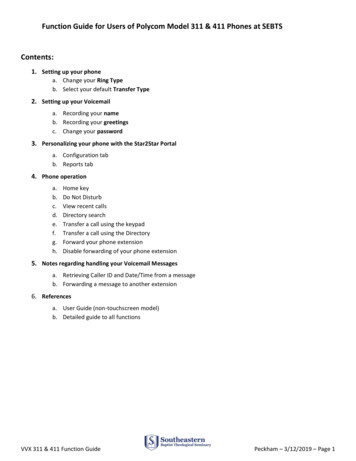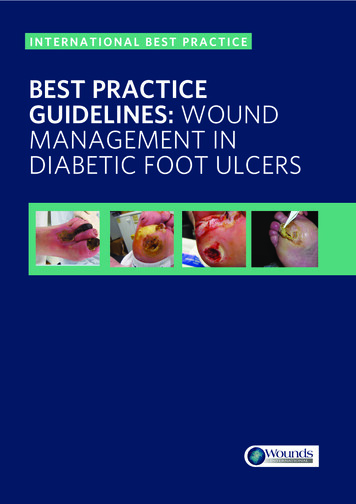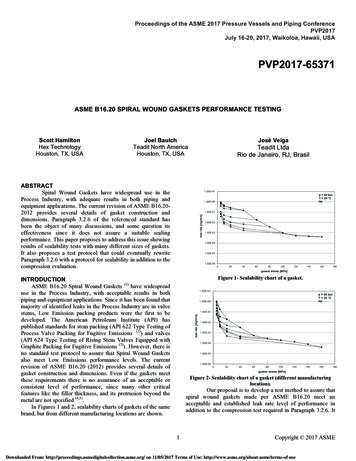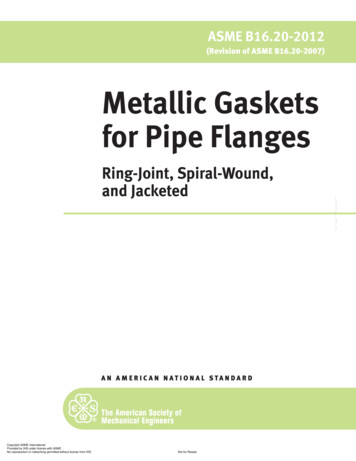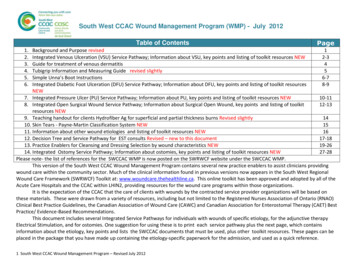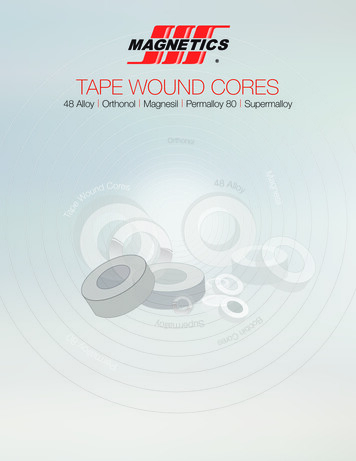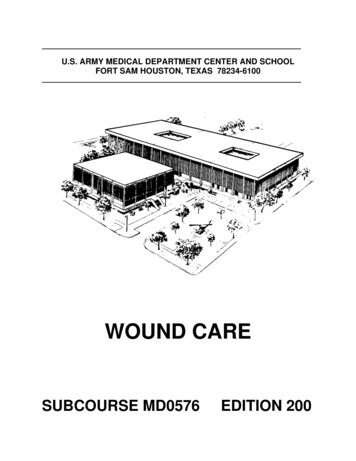
Transcription
U.S. ARMY MEDICAL DEPARTMENT CENTER AND SCHOOLFORT SAM HOUSTON, TEXAS 78234-6100WOUND CARESUBCOURSE MD0576EDITION 200
DEVELOPMENTThis subcourse is approved for resident and correspondence course instruction. Itreflects the current thought of the Academy of Health Sciences and conforms to printedDepartment of the Army doctrine as closely as currently possible. Development andprogress render such doctrine continuously subject to change.ADMINISTRATIONFor comments or questions regarding enrollment, student records, or shipments,contact the Nonresident Instruction Section at DSN 471-5877, commercial (210) 2215877, toll-free 1-800-344-2380; fax: 210-221-4012 or DSN 471-4012, e-mailaccp@amedd.army.mil, or write to:COMMANDERAMEDDC&SATTN MCCS HSN2105 11TH STREET SUITE 4192FORT SAM HOUSTON TX 78234-5064Approved students whose enrollments remain in good standing may apply to theNonresident Instruction Section for subsequent courses by telephone, letter, or e-mail.Be sure your social security number is on all correspondence sent to the Academy ofHealth Sciences.CLARIFICATION OF TRAINING LITERATURE TERMINOLOGYWhen used in this publication, words such as "he," "him," "his," and "men" are intendedto include both the masculine and feminine genders, unless specifically stated otherwiseor when obvious in context.USE OF PROPRIETARY NAMESThe initial letters of the names of some products are capitalized in this subcourse. Suchnames are proprietary names, that is, brand names or trademarks. Proprietary nameshave been used in this subcourse only to make it a more effective learning aid. The useof any name, proprietary or otherwise, should not be interpreted as an endorsement,deprecation, or criticism of a product; nor should such use be considered to interpret thevalidity of proprietary rights in a name, whether it is registered or not.
TABLE OF CONTENTSLessonParagraphsINTRODUCTION1WOUND HEALING AND WOUND CARE .1-1--1-6Exercises2CONTAMINATED WOUNDS .2-1--2-5Exercises3BURNSSection I.Severity and Causes of Burns .3-1--3-3Section II.Electrical, Lightning, Chemical, Inhalation, andRadiant Burns.3-4--3-8Section III.Thermal Burns.3-9--3-19Section IV.Fluid Replacement and Measurement ofUrine Output .3-20--3-22Topical Antimicrobial Dressings .3-23--3-27Section V.ExercisesMD0576i
CORRESPONDENCE COURSE OFTHE U.S. ARMY MEDICAL DEPARTMENT CENTER AND SCHOOLSUBCOURSE MD0576WOUND CAREINTRODUCTIONIn this subcourse, you will study wound healing and wound care, contaminatedwounds, and burns. Information you read in this subcourse will aid you in maintainingand improving the health of soldiers. In that pursuit, do your best to achieve theobjectives of this subcourse.Subcourse Components:The subcourse instructional material consists of three lessons as follows:Lesson 1, Wound Healing and Wound Care.Lesson 2, Contaminated Wounds.Lesson 3, Burns.Here are some suggestions that may be helpful to you in completing thissubcourse:--Read and study each lesson carefully.--Complete the subcourse lesson by lesson. After completing each lesson, workthe exercises at the end of the lesson--After completing each set of lesson exercises, compare your answers with thoseon the solution sheet that follows the exercises. If you have answered an exerciseincorrectly, check the reference cited after the answer on the solution sheet todetermine why your response was not the correct one.Credit Awarded:Upon successful completion of the examination for this subcourse, you will beawarded 4 credit hours.To receive credit hours, you must be officially enrolled and complete anexamination furnished by the Nonresident Instruction Section at Fort Sam Houston,Texas.You can enroll by going to the web site http://atrrs.army.mil and enrolling under"Self Development" (School Code 555).MD0576ii
LESSON ASSIGNMENTLESSON 1Wound Healing and Wound Care.LESSON ASSIGNMENTParagraphs 1-1--1-6.LESSON OBJECTIVESAfter completing this lesson, you should be able to:SUGGESTIONMD05761-1.Identify terms and definitions relating to wounds.1-2.Identify physiological responses to injury.1-3.Describe procedures for general wound care.1-4.Describe procedures for specific wound care.1-5.Describe the steps of wound healing.After completing the assignment, complete theexercises at the end of this lesson. These exercises willhelp you to achieve the lesson objectives.1-1
LESSON 1WOUND HEALING AND WOUND CARE1-1.WOUND TERMINOLOGYa. Definitions. A wound is a break in the continuity of the skin, the breakcaused by violence or trauma to the tissue. A wound may be open or closed. In aclosed wound or bruise, the soft tissue below the skin surface is damaged, but there isno break in the skin. In an open wound, the surface of the skin is broken. Here aresome terms referring to wounds that you should become familiar with.(1) Abrasion. In this type of wound, the outer layers of skin or mucousmembrane are rubbed or scraped off (figure 1-1).Figure 1-1. Abrasion.(2) Incised. This type of wound is cut smooth and straight. The rate ofbleeding varies and there is minimal contamination. A surgeon makes this type ofwound (incision).MD05761-2
(3) Laceration. This wound is a torn, jagged cut which has gone through theskin tissues and blood vessels (figure 1-2). The wound can be made by bluntinstruments such as shell fragments. Lacerations are usually very dirty.Figure 1-2. Laceration.(4) Puncture. A puncture wound (figure 1-3) is made by a sharp object suchas a splinter, knife, nail, or some other pointed object. These wounds bleed very littlealthough the object may pass through nerves, bones, and organs, causing internaldamage. Puncture wounds are usually very dirty.Figure 1-3. Puncture.(5) Perforating. A perforating wound is one in which there is an entranceand/or an exit. Such a wound might be made by a bullet.(6) Mutilating. This is the term for wounds which result in disfigurement orloss of a body part.MD05761-3
(7) Contusion. This wound is caused by a blunt object. The damage isdone to underlying tissues or organs, and the wound is closed with no broken skin(figure 1-4).Figure 1-4. Contusion.b. Wound Healing. Wound healing is a complicated process. A wound is abreak in the continuity of tissue. The body must have a special procedure to take careof the skin injury and dead tissue. The injured area must be able to signal distress, andthere must be some way to get rid of the dead cells and replace them with new cells.The process of wound healing is a way of restoring living tissue so that the entire bodyis covered with skin.(1) The body's first response to cell damage is inflammation. The reactionis similar regardless of the cause--cut, burn, bruise, or pinch. The injury starts areaction which may be the release from the dead or injured cells of one of theirsubstances such as histamine. The released substances affect the capillaries. Thecapillaries dilate, widely increasing the blood supply that they can bring to the injuredarea. If the injury takes place in the skin or in the tissue close to the skin, the increasedamount of blood in that area causes the area to look red. Because the injured area hasa greater blood supply than the surrounding area, the wound site is warm to the touch.(2) As the capillaries dilate, the "mesh" of their walls also is opened.Normally, capillary walls allow water and electrolytes to pass through, but now thesewalls also permit extra fluid and some protein plasma to escape. This extra fluid intissue spaces produces swelling. Because the fluid is extra, the patient feels discomfortand a throbbing sensation. Sometimes just the swelling is enough to stimulate the painreceptors. The changes in the blood vessels are responsible for the basic symptoms ofinflammation: swelling, pain, redness, and heat.MD05761-4
(3) One of the substances released by injured cells attracts leukocytes.Leukocytes pass through capillary walls into damaged tissues. In an injury withextensive tissue damage, large amounts of the substance which attracts leukocytes arereleased. This substance may be absorbed and circulated in the blood stimulating theproduction of more white cells. If a blood count is taken at this time, there will be anincrease above normal in the number of white cells (leukocytosis).(4) Inflammation is sometimes accompanied by fever. It is not clear howinflammation influences the body's temperature-regulating center. It is possible that asubstance absorbed from the injured cells is the signal that stimulates the response offever.(5) Although the effects of inflammation are uncomfortable, they mayactually prove beneficial. Protein escapes into damaged tissue and forms a gelatin typesubstance; this substance keeps materials from moving out of the wound site into therest of the body. The patient experiences swelling and pain, both of which encouragehim to be rather quiet and rest the injured area. This keeps infection in the injured areafrom spreading to other parts of the body. Bacteria, or a substance such as a foreignchemical, could harm other tissues if spread by activity to other parts of the body.(6) Signs and symptoms of inflammation are so easy to see thatinflammation attracts a great deal of attention. A doctor relies on inflammation to helplocate and identify the place and type of body injury. It is possible to decide whether thebody is overcoming the problem or needs additional help by watching the sequence ofinflammation symptoms.c. Complications. Wound complication refers to anything abnormal in thehealing process. The term also refers to the loss of function of a body organ, thefunction loss caused by the initial wound. Infection is the single most common woundcomplication. Other complications of wound healing include continued bleeding, dyingtissue, and improper healing.(1) Continued bleeding. Bleeding must be stopped to allow the healingprocess to proceed.(2) Dying tissue. Tissues at the site of severe injuries may have beenseverely damaged by being deprived of their blood supply with its oxygen and nutrients.These tissues will die and must be removed or carried away in the capillaries for healingto take place properly.MD05761-5
(3)Results of improper healing.(a) A keloid is excessive scar tissue growth. It can appear in an areaof injury, looking like a smooth overgrowth of fibroblastic tissues (tissues composed ofspindle-shaped cells). Keloids occur primarily in dark-skinned people, but given theproper conditions, anyone can develop a keloid. Keloids can be removed surgically forcosmetic reasons.(b) A localized infection in which there is an accumulation of pus is anabscess. Pus is a liquid accumulation of phagocytes (also called leukocytes). Anabscess is caused by an infecting microorganism. The particular microorganismdetermines whether the pus is white, yellow, pink, or green.(c)Inflammation of the cellular tissue surrounding the wound iscellulitis.(d) If pus collects in an already existing cavity such as the gallbladderor lung, the term used is empyema.(e) A fistula is an abnormal passage between two internal organs. Awound that heals improperly can cause this passage.d. Anemia. In anemia, hemoglobin levels are lower resulting in tissue hypoxia(abnormally low amount of oxygen in the body tissues). This changes collagensynthesis and epithelialization, both functions in the healing process. The bodycompensates by increasing blood circulation in a person with mild anemia. If thevolume percentage of red blood cells in the whole blood drops below 20 percent, thelower oxygen tension in the tissues can disrupt local metabolism for cell regeneration.e. Immunosuppression. When a wound to the body occurs, inflammation isthe immediate response. Body tissue around the wound becomes red, swollen, a littlehot, sometimes painful, and sometimes there is a loss of function in that body part.Immuno-suppression is a change, in a negative way, of the body's response to a foreignsubstance. The body produces fewer, poorer quality leukocytes (white blood cells),fewer immunoglobulins (proteins functioning as specific antibodies), or a lesser abilityfor collagen synthesis. All of these are necessary for tissue repair.f. Foreign Body in the Wound. A foreign body in a wound serves as a focalpoint for infecting microbes or preventing tissue granulation (formation of small, fleshymasses on the surface of a healing wound). Heart pacemakers and artificial legs, forexample, are necessary but also qualify as foreign objects that can harbor microorganisms and cause infection. Sutures (stitches used in surgery to unite two surfaces)also qualify as foreign substance and can be the source of infection. Sutures that aretoo tight can also cause a wound to heal improperly. The sutures can disrupt thecollagen network, compromising the tensile strength. After the scab shrinks, the finalscar is wider than normal.MD05761-6
g. Blood Supply. Since blood supplies the products used in healing, any factorwhich restricts blood circulation to a wound area interferes with healing. Dead oredematous tissue, restrictive bandages, and damaged arteries can all slow the healingprocess.1-2.PHYSIOLOGICAL RESPONSES TO INJURYOnce the skin and tissue have been injured, the process of healing begins.Many factors influence the body's ability to grow new tissue.a. Age. Very young and very old people heal more slowly than those in otherage groups. People in these age groups have less ability to fight infection, and fightinginfection is a major part of the healing process. The endocrine functions in infants aresluggish, and infants have limited reserves of fat, glycogen, and extracellular water--allwhich are necessary to fight infection. Healing is slower in the elderly becausecardiovascular, renal, pulmonary, and musculoskeletal functions may be slowed downby chronic disease or perhaps just by the wearing out of body parts.b. Malnutrition. Malnourishment and obesity, both forms of malnutrition, affectwound healing. A person who is undernourished has less fat and carbohydrate reserve;therefore, body protein (necessary for wound healing) must be used to provide energyneeded for basic metabolic functions. This results in an imbalance of nitrogen which inturn depresses fibroblastic synthesis of collagen, the connective tissue for scarformation. A person suffering from Vitamin C deficiency may not be able to producefibroblast causing a delay in wound healing. In obese individuals, fatty tissue may keepforeign matter from being seen. Fatty tissue has relatively few blood vessels, causingsuch tissue to separate easily. Tissue which separates easily heals slowly.c. Abnormalities in Endocrine Function. Healing is slower if there are suchabnormalities. In a person suffering from chronic vascular changes, the injured tissuesof the wound may not get enough blood to heal at a normal rate. Persons havingcorticosteroid therapy will find that wounds heal more slowly.d. Hormone Production and Carbohydrate Metabolism. The combined effectof the increased hormone production is to increase the metabolism of carbohydrates.The metabolism of carbohydrates is important in the body's response to trauma. If thebody's store of carbohydrates is depleted (severe crush injuries, starvation), the bodywill begin to use fats and proteins in place of carbohydrates. Eventually, there will notbe enough carbohydrates to aid in the healing process.MD05761-7
1-3.GENERAL WOUND CAREa. Immediate Care. Initially, control the bleeding from the wound. Natureusually stops bleeding. For example, a person cuts his finger. Blood will gush from thelacerated blood vessels. These vessels constrict which tends to lessen the bleeding.The clotting process also stops bleeding. When blood escapes from an artery or vein,the blood undergoes changes which cause it to clot. The blood clot seals off the injuredblood vessels, and bleeding stops. If the wound is large or clotting does not occur,apply direct pressure over the wound to stop bleeding. Use sterile pads if possible, butif they are not available, use a handkerchief, clean cloth, or even a bare hand as a lastresort. Then, check the entire body for injuries.b. General Evaluation. Make a general evaluation of the patient. Take care ofhim as a whole. Examine the patient from head to toe, checking for associated injuries.Follow the guidelines given below.(1)Check his entire body for injuries.(2)Ensure the airway is secure, spinal injuries are immobilized, etc.(3) If there is an injury in an extremity, check the distal pulse and sensationin that extremity.(4)Obtain a history of how the wound occurred.(5) Find out what medications the patient is taking: steroids,chemotherapeutic agents, anticoagulants, anti-inflammatory, etc.(6) Ask if the patient has any illness or chronic diseases such as diabetes,cancer, peripheral vascular disease (PVD), or anemia. (Wound healing may be difficultfor a patient with a chronic disease or illness.)(7)Ask if he has a current tetanus immunization.(8)Find out if the patient has any allergies.c. General Wound Care (Not Life- or Limb-Threatening). Follow thisprocedure to care for general wounds. Begin by removing foreign bodies, then coverthe wound with a sterile dressing. This is enough if immediate evacuation is possible. Ifevacuation is delayed, follow the procedure given below.(1) Cover the wound and clean the surrounding area with povidone-iodinesolution (dilute).(2) Uncover the wound and irrigate it with water. Sterile water or normalsaline is preferred if available, but using potable water is better than doing nothing.MD05761-8
(3) Irrigate repeatedly with water using a syringe and 18-gauge catheter.This will help obtain the optimal pressure required to clean the wound without using toomuch pressure that could cause debris to be forced deeper in the wound.(4)Change gloves and blot the area dry with a sterile dressing.(5)Cover the packing with a dry, sterile dressing.(6)Clean and dress the wound every 24 hours.d. Wound on Extremity. If the wound is on an arm or leg, splint the wound andelevate the arm or leg. Elevating such an extremity increases blood circulation, thusaiding in the healing process.e. Local Wound Procedures. Do not suture the wound closed. Follow thisprocedure to care for a local wound.(1)Cleanse the surrounding skin with surgical soap and water.(2)Irrigate the wound profusely with sterile saline in a syringe.(3) Apply antiseptic solution to the surrounding skin. These steps are takenin an effort to prevent infection. Skin and mucous membranes normally havemicroorganisms on them. To reduce the risk of transferring these microorganisms tothe wound, antiseptic is used on and around the wound.(4) Remove foreign matter and dead tissue as early as possible, preferablywithin the first eight hours after injury. Remove only enough skin tissue as necessary.Remove only the edges of fascia (connective tissue that covers the body under theskin). Any wound requiring more significant exploration should be evaluated by thesurgeon.1-4.SPECIFIC WOUND CAREa. Abrasion.(1) Description. Friction or scraping causes an abraded wound or anabrasion. This type of wound is superficial. The outer layers of skin or mucousmembrane have been damaged or scraped off. A person falling on his knees on asidewalk will suffer an abrasion.(2)Treatment. Treat as follows:(a) Irrigate the wound as previously stated.MD05761-9
(b) Apply antibiotic ointment such as bacitracin.(c)Cover the wound with a dry, sterile dressing.b. Contusion.(1) Description. A contusion or contused wound occurs as a result of a blowfrom a blunt instrument, such as a hammer. There is no break in the skin.(2) Treatment. First apply
THE U.S. ARMY MEDICAL DEPARTMENT CENTER AND SCHOOL SUBCOURSE MD0576 WOUND CARE INTRODUCTION In this subcourse, you will study wound healing and wound care, contaminated wounds, and burns. Information you read in this subcourse will aid you in maintaining and improving the health of soldiers. In that pursuit, do your best to achieve the
